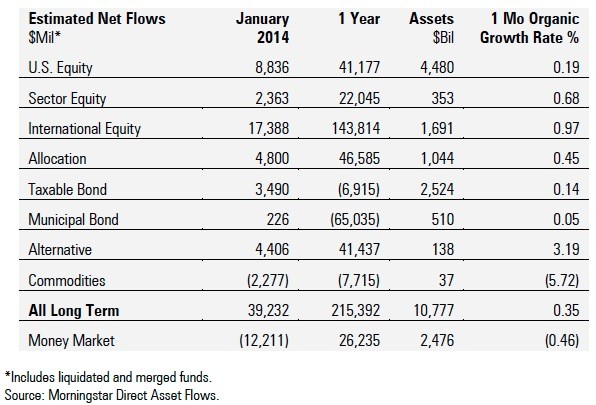Commodity Mutual Funds
Post on: 21 Июнь, 2015 No Comment

Commodity mutual funds provide excellent diversification and inflation protection to the average investor’s portfolio. Therefore, adding a commodities mutual fund to your portfolio is highly recommended.
Most commodity mutual funds are designed to track one of the various commodity indexes, and commodities indexes that are not heavily biased toward the energy sector show very little correlation with the general market and essentially no correlation with Treasury bonds. The only asset class that is significantly correlated with commodities is natural resources, which is due to the significant investments of both in energy. So, you will gain excellent diversification by adding commodities to your portfolio but you need to remember that energy is well represented in the general market and also tends to be over-weighted in most natural resources funds, so be careful you don’t inadvertently overload your portfolio with energy investments.
Although commodity mutual funds provide excellent diversification, the Commodity sector’s performance has been less than stellar in consideration of its volatility. Indeed, the sector underperformed the general market most of the time from 1998 to early 2008, spiked above the market in early 2008 and tracked the market since autumn 2008, which is reflected in the performance of commodity funds. However, the benefits of diversification may outweigh the difference in performance.
Unfortunately, there aren’t many commodity mutual funds to choose from and most of them are over-weighted in the energy sector. You could avoid this over-weighting by investing in a fund that tracks the Dow Jones-AIG Commodity Index (DJ-AIG), if there were any. However, the weightings are only reset once per year, so a group that is rising in price at a quicker pace than the rest of the groups can grow well beyond 33% over the course of a year. And you can expect the energy group to be reset at the maximum of 33% every January. Although there are currently (March 2012) no mutual funds that track the DJ-AIG index, the iPath Dow Jones-AIG Commodity Index Total Return ETN is an alternative that does track the index.
Another index that is not over-weighted in energy and is very well diversified is the Rogers International Commodities Index (RICI). Unfortunately, there are currently (March 2012) no mutual funds that track this index. However, the ELEMENTS Rogers International Commodity ETN (RJI) tracks the RICI and is therefore a viable alternative to investing in a mutual fund. (Disclosure: Although I hold a small position in RJI, this information is provided purely as a convenience to our visitors, many of whom have landed on this page while searching for this information.)
Being that there aren’t any no load commodity mutual funds to pick from, you might have to break down and buy a load fund, an ETF an ETN or TRAKRS, if you have an account where purchasing these securities is an option. The Rogers TRAKRS, which track the RICI, are simplified commodities futures contracts that trade like regular securities on the Chicago Mercantile Exchange (CME). (Be sure you understand the applicable fees and commissions before investing in TRAKRS.) I’m not recommending that you buy any of these. You should look at the alternatives, including ETFs, ETNs and funds that track other indexes and go with the one you are most comfortable with. For instance, you may prefer a fund that tracks an index that has a larger energy component.
Agriculture
To cover agriculture adequately, you also may need to invest in an agricultural mutual fund or agricultural ETFs and ETNs unless you pick a commodity mutual fund, ETF, ETN or TRAKR that tracks the RICI or the DJ-AIG, as both the RICI and the DJ-AIG have solid agricultural components. 32% and 30%, respectively. Unfortunately, the only agricultural mutual fund I’m aware of, Fidelity Select Food & Agriculture (FDFAX), has changed its name and investment strategy. It is now Fidelity Select Consumer Staples and has diversified way beyond agricultural commodities. So that leaves us with ETFs and ETNs
The following ETFs and ETNs invest solely in agricultural commodities:
- Market Vectors Global Agribusiness ETFs (MOO) track the DAXglobal Agribusiness Index
- PowerShares DB Agriculture ETFs (DBA) invest in corn, wheat, soybeans and sugar
- Elements Rogers International Commodity Agriculture ETNs (RJA) track the Rogers Agricultural Commodities Index, a 20-component index (Disclosure: I hold a small position in RJA.)
- iPath Dow Jones — AIG Grains ETNs (JJA) invest in soybeans, wheat and corn
- E-Tracs UBS Bloomberg CMCI Agriculture ETNs (UAG) are linked to the UBS Bloomberg CMCI Agriculture Index
- Opta Lehman Brothers Commodity Agriculture ETNs (EOH) are linked to the Lehman Brothers Commodity Index Agriculture
Commodity Investing by Proxy
Investing in commodities indirectly by holding funds that are specific to countries whose economies are highly dependent on commodities is an alternative to commodity mutual funds. If you read the subsection on natural resource funds you should recall that I also suggested this option for natural resources, so if you follow this strategy, you’ll want to do it in sync with natural resources. The economies of Australia, New Zealand, South Africa and Canada are highly dependent on mining and agriculture. But bear in mind that Canada is heavily weighted toward natural resources and energy, and South Africa is light on agriculture.
Commodity mutual funds, ETFs and ETNs currently invest worldwide, thus eliminating the need to make both domestic and international investments and decide how they should be weighted. Commodities and natural resources are two sectors where a World investment makes good sense.














